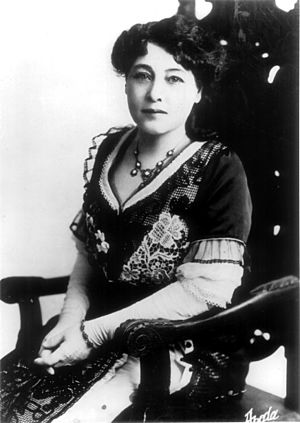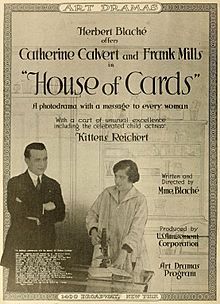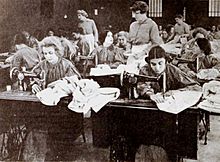Alice Guy-Blaché facts for kids
Quick facts for kids
Alice Guy
|
|
|---|---|

Alice Guy-Blaché in 1913
|
|
| Born |
Alice Ida Antoinette Guy
1 July 1873 Saint-Mandé, Val-de-Marne, France
|
| Died | 24 March 1968 (aged 94) Wayne, New Jersey, U.S.
|
| Resting place | Maryrest Cemetery, Mahwah, New Jersey, U.S. |
| Nationality | French |
| Occupation |
|
| Years active | 1894–1922 |
| Spouse(s) |
Herbert Blaché
(m. 1907; div. 1922) |
| Children | 2 |
Alice Guy-Blaché (born Alice Ida Antoinette Guy; 1 July 1873 – 24 March 1968) was a French filmmaker who was a true pioneer. She was one of the very first people to make a story film. She was also the first woman ever to direct a film.
For about ten years (1896-1906), she was likely the only female filmmaker in the world. She tried out new things like sound in movies, adding color, using actors of different races, and creating special effects.
She helped start Solax Studios in New York and was its artistic director. In 1912, her studio built a big new place in Fort Lee, New Jersey. This area was the main place for filmmaking in America before Hollywood became famous. That same year, she made A Fool and His Money. This film was probably the first to have an all-African-American cast. Today, this film is kept safe because it is very important for history and art.
Contents
Early Life and Education
Alice Guy was born in France in 1873. Her father owned a bookstore and publishing company in Chile. Her parents had four other children.
In 1872 and 1873, there was a serious sickness in Chile. So, Alice's parents brought their children back to Paris, France. Alice was born there. Her parents wanted her to be "truly French."
Soon after Alice was born, her father went back to Chile. Her mother followed a few months later. Alice stayed with her grandmother in Carouge, Switzerland. When Alice was three or four, her mother came back and took her to South America.
At age six, Alice went back to France for school. She and her sister Louise studied at a convent. Later, they moved to another convent and then returned to Paris.
Alice's father died in 1891. After his death, Alice's mother got a job. But she could not keep it. So, Alice learned to be a typist and stenographer. This was a new job at the time. She did this to support herself and her mother. She first worked at a varnish factory. In 1894, she started working for a photography company. This company was later taken over by Léon Gaumont.
Amazing Film Career
Working at Gaumont in France
In 1894, Alice Guy started as a secretary for a camera company. In 1895, the company was sold to four men, including Léon Gaumont. The company was named Gaumont. It became a very important company in the early film industry in France. Alice kept working there. This led to her amazing career in filmmaking. She worked for over 25 years. She directed, produced, wrote, or oversaw more than 700 films!
Alice started as Léon Gaumont's secretary. But she learned a lot about cameras and how to sell them. She also met famous film engineers like Auguste and Louis Lumière.
Alice and Gaumont went to a special event in 1895. It was the first time a film was shown using a projector. They saw a simple film called Workers Leaving the Lumière Factory. Alice thought that films could be more than just demonstrations. She believed films could tell stories. She asked Gaumont if she could make her own film, and he said yes.
Alice Guy made her first film in 1896. It might have been called La Fée aux Choux (The Fairy of the Cabbages). This first film seems to be lost now. But we know it was about children being born from cabbages. Alice said that soon, every film company was making story films instead of just showing scenes.
From 1896 to 1906, Alice Guy was in charge of production at Gaumont. She is seen as the first filmmaker to really develop story films. She was probably the only female director during this time. Her early films were like those of other filmmakers. She made films about dance and travel. For example, Le Boléro (1905) and Tango (1905).
In 1906, she made The Life of Christ. This was a very big film for its time. It had 300 extra actors. She used pictures from the New Testament to help make the film. It had 25 parts and was her biggest film at Gaumont.
Alice was also a pioneer in using sound with films. She used Gaumont's "Chronophone" system. This system used a special disc that played sound while the film ran. She also used some of the first special effects. These included showing two images at once, using masks to change parts of the screen, and playing film backward. While at Gaumont, Alice hired and trained other filmmakers.
Starting Solax Studios
In 1907, Alice Guy married Herbert Blaché. He soon became a manager for Gaumont in the United States. After working with her husband for Gaumont in the U.S., they decided to start their own company. In 1910, they formed The Solax Company. This became one of the biggest film studios in America before Hollywood.
Their new company had film-making places in Flushing, New York. Her husband was in charge of production and filming. Alice Guy-Blaché was the artistic director and directed many films. They were so successful that in two years, they spent over $100,000 on new, modern studios in Fort Lee, New Jersey. Many early film studios were in Fort Lee. This made Alice the first woman to own her own film studio. It was said that she put a big sign in her studio that read: 'Be Natural'.
In 1913, Guy-Blaché directed The Thief. This was the first script sold by William Moulton Marston. He later created the famous Wonder Woman comic book character.
Alice Guy-Blaché and her husband divorced later. Also, Hollywood became a better and cheaper place to make movies. So, their film partnership ended.
Her Lasting Impact
"There is nothing connected with the staging of a motion picture that a woman cannot do as easily as a man, and there is no reason she cannot master every technicality of the art...In the arts of acting, painting, music, and literature women have long held their place among the most successful workers, and when it is considered how vitally these arts enter into the production of motion pictures one wonders why the names of scores of women are not found among the most successful creators of photodrama offerings."—Alice Guy-Blaché in The Moving Picture World, July 11, 1914.
In the late 1940s, Alice Guy-Blaché wrote her life story. It was published in French in 1976. It was translated into English later with help from her family. Alice was very worried that she was not being remembered in film history. She often talked to film historians. She corrected mistakes about her life. She made long lists of her films. She wanted to make sure she got credit for her work.
A documentary film about her was made in 1995. It was called The Lost Garden: The Life and Cinema of Alice Guy-Blaché. In 2002, a book called Alice Guy Blaché: Lost Visionary of the Cinema was published. Some people believe Alice Guy-Blaché was the first female filmmaker. From 1896 to 1920, she directed over 1,000 films. About 150 of these films still exist today. 22 of them are feature-length films. She was one of the first women to own and manage her own studio, Solax Company.
In 2018, a collection of films called Pioneers: First Women Filmmakers was released. The first disc in this set is all about Alice Guy-Blaché's films. One of her films, Matrimony's Speed Limit (1913), was chosen to be saved in the National Film Registry in 2003. A 2018 documentary film, Be Natural: The Untold Story of Alice Guy-Blaché, tells her life story. It was narrated by Jodie Foster.
Because of the "Be Natural" documentary, many of Alice Guy-Blaché's films were fixed and saved. A special pillar in her name will be at the Academy Museum of Motion Pictures. In 2019, The New York Times wrote about her in their "Overlooked No More" series.
Alice Guy-Blaché influenced famous directors like Alfred Hitchcock and Sergei Eisenstein. Hitchcock said he was "thrilled" by her movies. Eisenstein remembered one of her films from his childhood. It was The Consequences of Feminism (1906).
Personal Life
When Alice Guy-Blaché got married, she had to leave her job at Gaumont. She and her husband went to the United States. In 1908, Alice gave birth to her daughter, Simone, in New York City. Two years later, Alice became the first woman to run her own studio, Solax.
In 1912, while she was expecting her second child, she built a new studio in Fort Lee, New Jersey. She continued to make one to three films every week. Her son, Reginald, was born in June 1912. To focus on writing and directing, Alice brought her husband into Solax in 1913.
Soon after, Herbert Blaché started his own film company. Alice and Herbert worked together on many projects for a few more years. In 1918, Herbert Blaché moved to Hollywood. Alice Guy-Blaché became very sick with the Spanish flu in October 1918. This was while she was filming her last movie, Tarnished Reputations. After she got better, she joined Herbert in Hollywood in 1919. But they lived separately. She helped Herbert direct two films.
Alice Guy-Blaché directed her last film in 1919. In 1921, she had to sell her film studio and other things because of money problems. Alice and Herbert officially divorced in 1922. She went back to France in 1922 and never made another film.
Death
Alice Guy-Blaché never married again. In 1964, she moved back to the United States. She lived with her daughter, Simone, in Wayne, New Jersey. On March 24, 1968, Alice Guy-Blaché died at age 94. She was buried in Maryrest Cemetery in New Jersey.
Awards and Tributes
On December 12, 1958, Alice Guy-Blaché received the Legion of Honour. This is the highest award France gives to civilians. In 1957, she was honored at a ceremony in France.
In 2002, a musical about the invention of cinema was made in Los Angeles. Alice Guy-Blaché was the main character. In 2011, a play called Flight showed a fictional version of Alice Guy-Blaché as a filmmaker.
In 2004, a historical marker was placed at the site of Solax Studio in Fort Lee. It was dedicated to Alice Guy-Blaché. In 2012, funds were raised to replace her grave marker. The new marker includes the Solax logo. It also notes her role as a film pioneer.
In 2010, her short film The Girl in the Arm-Chair was preserved. In 2011, the Directors Guild of America accepted Alice Guy-Blaché as a member. She was given a special award for her lifetime achievements. In 2013, Guy-Blaché was added to the New Jersey Hall of Fame.
A square in Paris, France, is named Place Alice-Guy in her honor.
In 2019, a new version of Sergei Eisenstein's memoirs mentioned Alice's film The Consequences of Feminism. It talked about how it influenced him.
In 2021, Yale University opened a new screening room. It was named the Alice Cinema, after Alice Guy-Blaché.
In 2022, a new edition of The Memoirs of Alice Guy Blaché was published.
The Golden Door Film Festival gives an award named after her.
Selected Films
These films were made by Gaumont (1896–1907), Solax (1910–1913), or other companies (1914–1920).
- La Fée aux Choux (The Fairy of the Cabbages; 1896)
- Le pêcheur dans le torrent (The fisherman in the stream; 1897)
- Le chiffonnier (1898)
- Danse serpentine (1900)
- Les Fredaines de Pierrette (1900)
- Les chiens savants (1902)
- Esméralda (1905) (based on the Victor Hugo novel The Hunchback of Notre Dame)
- Une histoire roulante (1906)
- The Birth, the Life and the Death of Christ (1906)
- Les Résultats du féminisme (1906)
- The Game-Keeper's Son (1906)
- Madame a des envies (1906)
- La barricade (1907)
- Fanfan la Tulipe (1907)
- One Touch of Nature (1910)
- The Sergeant's Daughter (1910)
- The Pawnshop (1910)
- Greater Love Hath No Man (1911)
- Algie the Miner (1912)
- Falling Leaves (1912)
- A Fool and His Money (1912)
- Making an American Citizen (1912)
- The Girl in the Armchair (1912)
- The Pit and the Pendulum (1913)
- Matrimony's Speed Limit (1913)
- A House Divided (1913)
- Shadows of the Moulin Rouge (1913)
- The Lure (1914)
- The Shooting of Dan McGrew (1915)
- The Vampire (1915)
- The Ocean Waif (1916)
- What Will People Say? (1916)
- The Adventurer (1917)
- The Empress (1917)
- The Great Adventure (1918)
- Tarnished Reputations (1920)
See also
 In Spanish: Alice Guy para niños
In Spanish: Alice Guy para niños
- Women's cinema




